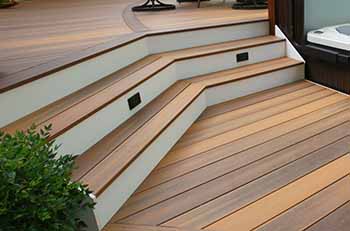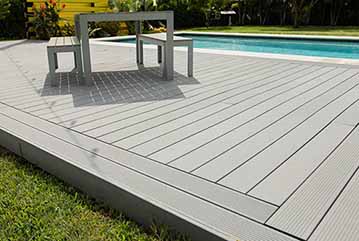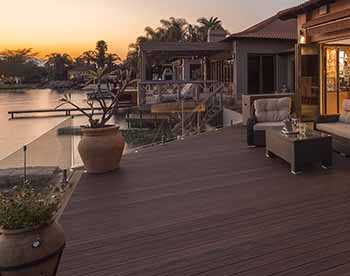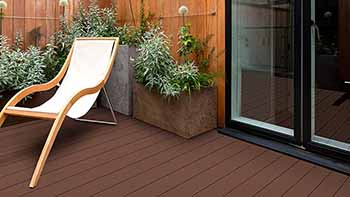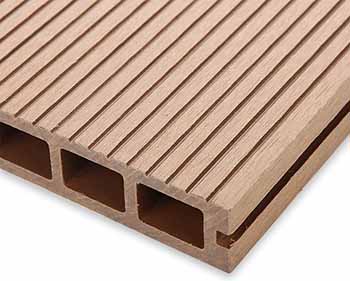Composite Bamboo Decking: What Is It?
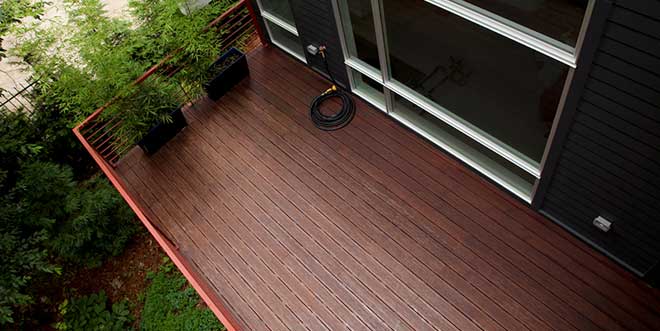
a twist on bamboo and traditional composite decking that looks really good
Composite Bamboo Decking has arrived
Composite bamboo decking is the latest incarnation of bamboo - and it seems to have some very nice benefits.
If you read our previous article about the pros and cons of bamboo as an outdoor deck board, you will recall that the earliest entrants to the market were poor performers. They were long single strips of bamboo that looked similar to a counter top or even chopsticks.
The sugars were still inside the wood and that provided food for insects, fungus and mold. The adhesives were also not well suited for the harsh outdoor environment. So the boards deteriorated and performed poorly.
These were hard lessons that engineers and chemists learned. They went back to the drawing board determined to solve these problems. And solve them they did. The result was a couple of solutions that seem to be working very well.
engineered boards for high performance
Fused bamboo is one of the engineered bamboo decking boards we wrote about a couple years ago and is made by Dasso USA and Moso in Europe. The process involves cooking the sugars out of the bamboo and then compressing the bamboo strips into a phenolic resin under heat to create a very tough beautiful looking product.
capped composite technology but with bamboo
Composite bamboo decking is a variation on the traditional composite decking where bamboo replaced domestic recycled hardwoods mixed with high density polyethylene plastic.
Bamboo makes a very fine, homogeneous and dense flour which is mixed with recycled plastics. The finished board is capped usually on four sides and a super strong dense board is the result. Some boards are over three times as strong as a traditional composite board. Some manufacturers offer non capped boards. A capped stock and particularly capped on all four sides is the most durable format.
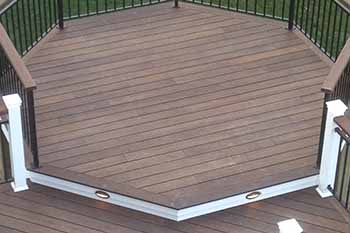
There are four major brands of composite bamboo decking that have emerged and really represent the best in this sub-category of decking. Let's take a look at each one and then you can go and dig deeper with your own research.
capped composite bamboo
Bam DEck by cali bamboo
Cali Bamboo has been in the bamboo business for a long time and manufacturing bamboo decking is merely one of their product lines.
Bam Deck Pro 360 is their premium four sided capped composite bamboo decking product. They use 60% recycled bamboo from their other product lines and mix it with 40% recycled HDPE (high density polyethylene). The bamboo makes a board which is more dense and stiffer than a common wood composite board. They come in 12', 16', and 20' lengths and while they may be heavier than a WPC board they are 3.6 times as strong.
The Pro 360 capping material that wraps the board is the same as that which is used for for the skin of a golf ball so it is very durable and protects your boards from scratching, staining fading and all the elements that it could be subjected to.
The finish of the board is a beautiful subtle grain pattern that is complimented by a variegated coloring in a matte finish to make what appears to be a perfect exotic hardwood board.
Bam Deck 3G and Pro 360 have hollow cores in their extrusions and this reduces weight, keeps the boards cooler and increases the tensile strength.
The bamboo material makes the board much denser which in turn makes it better suited for rainy or snowy climates because it is much more difficult for moisture to be absorbed. Keep in mind all composite materials that use wood of some sort of wood can theoretically absorb some moisture. But Bam Deck absorbs 90% less moisture than other composite boards.
This is a serious concern if you have a board capped on four sides because the ends must be sealed with a good coating of sealing wax. If water is absorbed the board will mushroom outwards at the end of the board. Some manufacturers say that is why they only cap their boards on three side. But the real reason is more likely because they can save 40% of the capping material. A board that is capped on only three sides has to be made perfectly so that the capping material adheres very well against the substrate and never separates.
infinity deck by fortress deck
From one of the harshest climates in the world comes one of the toughest composite bamboo decking in the world. Infinity decking is a creation of Eva-Last, a South Africkan composite deck board manufacturer.
The story goes that some of the premium composite decking at the time was shipped over to South Africa and it just didn't last. It could not handle the extreme sunlight or the heat. And so Eva-Last was born and their first challenge was to develop a superior synthetic composite decking board.
With years of testing and observation it was clear that Eva-Last had come up with a great solution and so Infinity Deck is now available in North America and distributed by Fortress Deck.
The idea for using bamboo in the flour, which is the mix of HDPE and bamboo, was that bamboo is less water absorbent than the native recycled wood used in North America. Bamboo is also much more dense and has a texture that makes for a very fine ingredient in the board extrusion process.
The boards are made of 55% bamboo and 35% recycled plastics,
much of which comes from water bottles. And since bamboo is a highly
renewable resource it makes for a good combination of materials that
seems to be pretty gentle on the environment.
Capping The Deck Board around all four sides
Inifinity Deck uses a patented capping technology which provides exceptional protection to the inner part of the board. The cap provides the best scratch, stain and fade resistance the industry can offer. Uses recycled water bottles and bamboo. Uses no toxic preservative common with natural wood flour composites. The boards are grooved or ungrooved and they work well with their proprietary Hulk fastener systems.
One thing you should consider is that because the boards are so dense and come in 20' lengths they are prone to slight linear expansion with extreme heat. A 20' board can increase in length by 1/4" to 3/4". That is about 0.025" per foot and is quite insignificant. However, it does mean you should allow for this potential expansion if you are butting boards up against each other.
They also conveniently make stair tread boards that are 12-7/8" wide which means one board can be used instead of two and there is plenty of room for nosing. Their fascia boards are made in 7-1/4" and 11-3/4" widths and 12' long.
The boards come with a twenty-five year warranty with no apparent distinction between residential or commercial applications. Be sure to check with Fortress about the details of their warranty but if that is the case it is one of the strongest warranties in the business.
non capped composite bamboo
inno deck by inno tech
Inno Deck is a composite bamboo material that combines the fiber of the bamboo with recycled high density polyethylene (HDPE). So they are able to achieve and solid color throughout the material. The grain is course and realistic on one side and then the opposite side has a tightly channeled grooved surface so you can choose which one to show.
The boards are available in solid and a hollow extrusion style. The extrusion style is at least 20% lighter than the solid composite and allows for any wiring for lighting to pass through if desired. And each of these boards are side grooved for the use of proprietary deck clipping fasteners.
Residential applications are warranted for twenty-five years and commercial applications are covered for ten years.
X Beam by zometek
xBeam composite bamboo by ZomeTek is another well made product. It is comprised of 96% recycled bamboo fibers and HDPE plastic. It is hollow channelled like Inno Deck making is much lighter than a solid composite. One side has a brushed finish while the other has a ridged channel finish. You can see by this image how perfect and fine the grain appears. It is well made and looks like an exotic piece of hardwood.
The brushed surface tends to make it look like a real exotic hardwood
and every piece is perfectly identical so you get a really nice modern
look.
Staining and sealing are not required according to the
manufacturer and it will weather to a natural grey patina. They claim
maintenance and fading is minimal. The residential warranty is
twenty-five years and the commercial warranty is ten years.
How to choose the bamboo composite for your deck?
Warranty
Look for a long residential warranty to start and then consider whether you want a solid or hollow core board. The solid boards will naturally absorb more heat given their density so if you are in a warm climate or your deck faces full southern exposure you may be wise to at least consider the hollow core material as it is likely to retain as much heat.
Solid or Hollow Core
If you choose a solid core material, a fully capped stock is always going to give you good piece of mind even though the core of a composite bamboo board is less water absorbent than a non-bamboo board.
Appearance
And then lastly, consider the cosmetic appearance of each board such as color and grain. These are fine distinctions but come down to personal preference. Overall we see this new category of composite bamboo as an exciting and positive development for homeowners and deck builders.
Comparing composite to solid bamboo boards
In our article about fused bamboo made by Dasso you will recall the solid boards were made in 6' lengths. This simplifies the manufacturing and the handling aspects of the product. Since fused bamboo is a solid wood board it has a lot of strength and is a very high performance material and is so stiff you can butt join boards between joists with no problem.
Whereas with composite bamboo the boards are anywhere from 12' to 20' long and they vary in stiffness and typically have to be installed at a maximum of 16" o.c. or 12" o.c. for diagonal boards. This means that the manufactured fused solid boards are more easy to handle. There is usually less waste and installation is generally as fast or faster than with longer lengths. It kind of installs like indoor flooring. So those are some installation tips to keep in mind.
Overall, composite bamboo decking looks to be a good step forward for the decking sector of the industry. Their is more selection than ever and the performance of the materials look to be very high indeed.
Home > Deck Materials > Bamboo Decking > Composite Bamboo





















